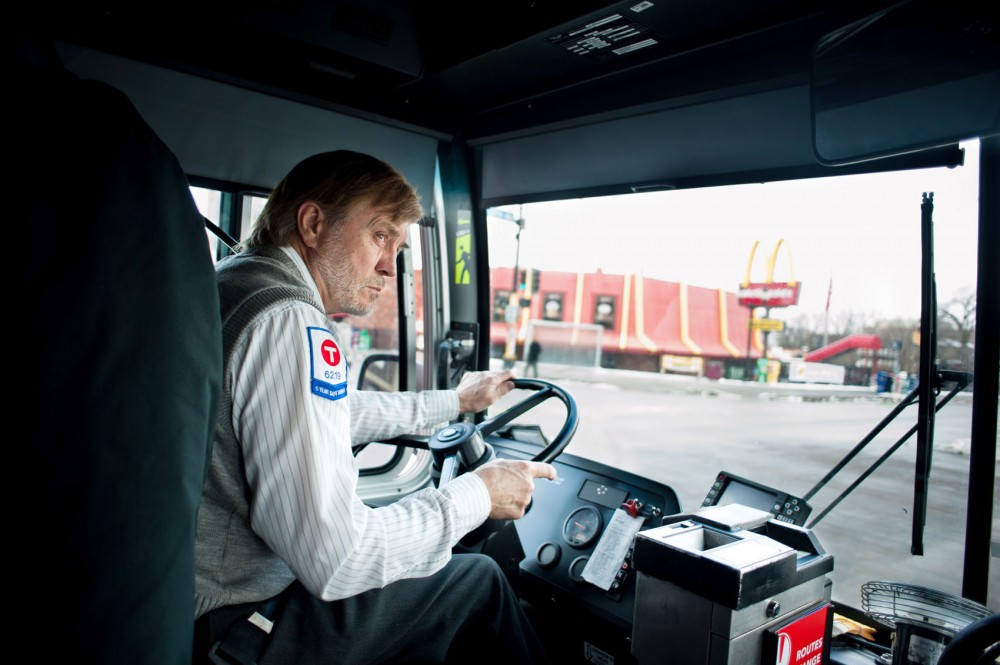The 3A takes a right-hand turn with care, rumbling from West Maryland Avenue to Rice Street on its usual route from downtown Minneapolis to downtown St. Paul.
“Those are hard corners to make,” the driver sighs.
Wayne Adermann, 64, sits behind the giant wheel, a gray sweater over his white and gray striped shirt, steering the bus through its usual route. For 20 years he has navigated Twin Cities’ streets as one of the Metro Transit bus drivers.
Metro Transit has been around in its current reincarnation since 1998. The company has 123 bus routes and 1,370 drivers, with nearly 70 million boardings in 2011.
More than 20 routes run through the University of Minnesota campus, including Adermann’s current route, which has some of the highest ridership numbers, said spokesman John Siqveland in an email. In 2011 the route served 2.74 million riders.
Adermann starts his eight-hour shift at 11 a.m. –– a rarity in the bus driving business. Most drivers start early morning or later in the afternoon.
Every three months the drivers switch routes. Adermann, who likes the consistent schedule and seeing regular riders, would have chosen to keep his current one, but somebody of higher seniority picked it before him.
“I like the same route all the time,” Adermann said. “Some drivers get bored –– it’s a difference in personalities.”
The daily grind
At the beginning of the day, drivers sign in, find their bus number and check for any new detours on the route. Anyone who is late forfeits their route to an on-call driver to ensure the bus keeps to its schedule.
The drivers pick their days off. Adermann works Tuesday through Saturday. But when he first started as a part-time driver working morning and evening rush hours, he said he never saw a free weekend –– those would be picked by senior drivers.
Adermann said he plans on working another five to 10 years, if he can continue to pass the physical exam. The exam, normally given every two years, tests drivers’ eyes, ears, lungs and heart to ensure they are able to safely operate the bus. Adermann who takes high blood pressure medicine gets his physical annually.
By noon, 17 passengers are on the bus, and it is a quiet ride. At 12:20 p.m. Adermann has finished the first trip to downtown St. Paul and takes a ten-minute layover break. He uses the time to stretch and check for lost items on the bus.
“It’s hard sitting in the seat,” Adermann says. “It’s like rigor mortis sets in. You have to learn to walk again.”
He gets back in his seat, buckles himself in and turns the bus around toward Minneapolis. Driving down Como Avenue, Adermann rehearses the five safety keys. The keys, reiterated every three years in classroom training, are: aim high, get the big picture, keep your eyes moving, leave yourself a way to get out and make sure you are seen.
The last key is important, Adermann said — a man once walked right into the side of his bus.
A lady sits with a cart of groceries, a man talks on his cellphone but mostly the riders just sit quietly, Adermann driving calmly through his route. Pulling up to another stop, the woman with the groceries struggles to get off. Adermann gets up, lifts her cart off the bus and helps her down. He is back on the bus and on the road without a second thought.
He greets every new rider with a “hello,” a smile and a nod.
Mary Gotz gets on the bus and sits down near the front. She has never owned a car and has ridden the bus her whole life. She sometimes tutors residents in her apartment building who don’t know how to ride the bus.
“It’s kind of a hidden jewel,” she said.
Student riders
By 1:15 p.m. the bus is at the University campus and is filled with students.
About 39 percent of students use buses as their main mode of transportation, according to an informal survey by the University of Minnesota’s Parking and Transportation Services said spokeswoman Jacqueline Brudlos. Active U-Passes totaled 17,464 in January 2012 said Siqveland.
The University also partners with Metro Transit experts to teach new students in residence halls about how to ride the bus, said Brudlos.
“Metro Transit is a key part of transportation plans,” she said. “We are constantly in contact with them to make sure all our needs are met.”
Adermann is about to pull away from the East Bank stop when he sees two students running toward the bus.
Even though his clock tells him he is ten minutes behind schedule, Adermann waits.
“It’s really driver’s discretion on whether or not to wait,” he said.
The drivers are given the 10 minute layovers at the end of the line in order to make up any time they are behind or ahead. When Adermann reaches the end of the line in downtown Minneapolis he has five minutes for a quick bathroom break.
“The hardest part of the job is … not drinking too much coffee,” Adermann says. “No, it’s understanding dialects. People ask where I’m going, and I haven’t been able to understand them.”
Going through the University campus once again, Adermann picks up almost a full bus of passengers. It is 2 p.m. and Adermann is approaching the busiest point in his route.
By 7 p.m. the bus headed into a garage in downtown Minneapolis, where the day’s ridership numbers and fares are collected.
When the workday was done, Adermann drove home in his car.
“I spent 23 years chained to a desk,” chuckled Adermann. “Now I’m chained to a steering wheel.”








